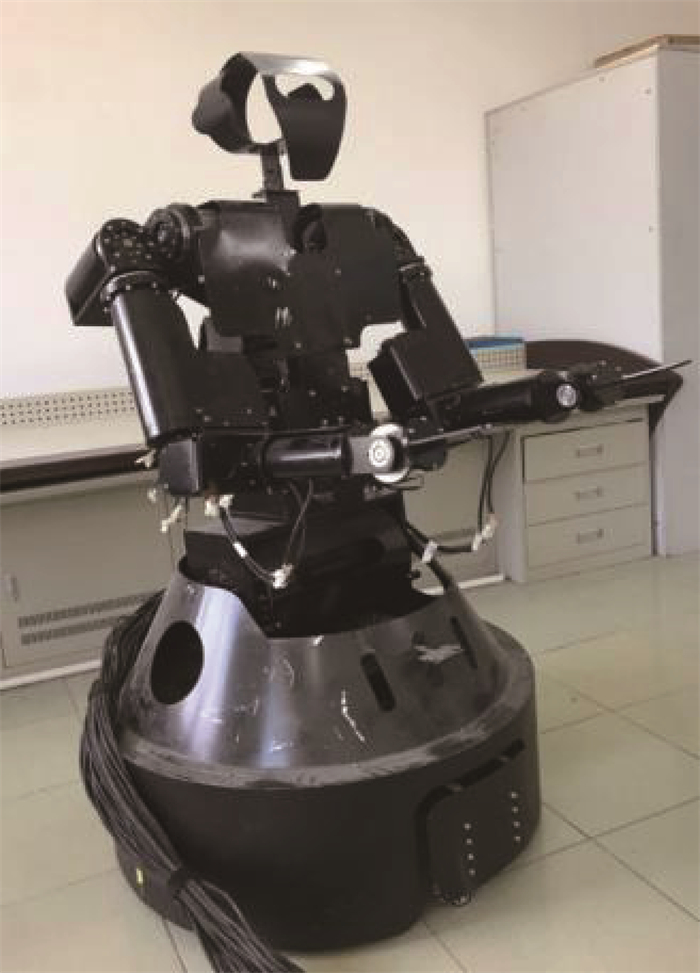-
摘要:
护理机器人结构复杂、耦合度高且机械臂不满足PIEPER准则,标准遗传算法难以精准地对其逆运动学进行求解,以至于机器人手臂末端位姿误差较大。针对标准遗传算法求解过程中早熟和局部搜索能力差的问题,采用等分区间替代随机命令产生的初始种群个体,划分5个小区间以提高种群个体的分散程度和搜索效率;在适应度函数中引入可变权因子,将位置误差的变化值作为可变权因子的变量,进化过程中可变权因子在0.5~1.0之间变化,且实时有效分配位置和姿态误差权重,确保解的收敛。通过仿真和实验验证,结果表明:改进后的遗传算法能够大幅提升收敛精度和速度,并且可以同时实现对位置和姿态的精确控制,极大地减小了机器人手臂的位姿误差。
Abstract:The nursing robot's arm does not meet the PIEPER criterion and is constructed with a high degree of coupling and complexity. The standard genetic algorithm is difficult to accurately solve its inverse kinematics. As a result, the pose error of the end of the robot arm is relatively large. In order to solve the problem that premature and poor local search ability in the standard genetic algorithm solution process, the following methods are proposed. Firstly, use equal partitions to replace the initial population of individuals generated by random commands. Divide 5 small areas to improve the dispersion of the population and search efficiency. Secondly, introduce variable weight factors in the fitness function. The change value of the pose error is used as the variable of the variable weight factor. The weight factor varies between 0.5-1.0 during the evolution process. And effectively assign position and attitude error weights. Finally, verified by simulation and experiment. The results show that the improved genetic algorithm can greatly improve the accuracy and speed of convergence, achieve precise control of position and attitude at the same time, and greatly reduce the pose error of the robot arm.
-
Key words:
- genetic algorithm /
- inverse kinematics /
- fitness function /
- nursing robot /
- attitude control
-
表 1 护理机器人运动学连杆参数
Table 1. Nursing robot kinematic linkage parameters
部位 关节i αi-1/(°) ai-1/mm di/mm θi/(°) 腰部 1 0 0 0 0 2 -90 345.0 65.5 0 左臂 3 -90 375.0 -313.0 0 4 90 0 -40.0 90 5 90 0 -423.0 90 6 90 0 105.0 0 7 0 347.5 0 0 右臂 3 -90 375.0 313.0 0 4 90 0 -40.0 90 5 90 0 -423.0 90 6 90 0 -105.0 180 7 0 347.5 0 0 -
[1] ATAWNIH A, PAPAGEORGIOU D, DOULGERI Z. Kinematic control of redundant robots with guaranteed joint limit avoidance[J]. Robotics and Autonomous Systems, 2016, 79: 122-131. doi: 10.1016/j.robot.2016.01.006 [2] FISCHINGER D, EINRAMHOF P, PAPOUTSAKIS K, et al. Hobbit, a care robot supporting independent living at home: First prototype and lessons learned[J]. Robotics and Autonomous Systems, 2016, 75: 60-78. doi: 10.1016/j.robot.2014.09.029 [3] GOOK B, ROSEN J. Kinematic analysis of 7 degrees of freedom upper-limb exoskeleton robot with tilted shoulder abduction[J]. International Journal of Precision Engineering and Manufacturing, 2013, 14(1): 69-76. doi: 10.1007/s12541-013-0011-4 [4] EIICHI Y, MATHIEU P. Whole-body motion planning for pivoting based manipulation by humanoids[J]. Applied Bionics and Biomechanics, 2006, 3(3): 227-235. doi: 10.1155/2006/683746 [5] 李娜托. 基于改进人工蜂群算法的冗余机器臂逆解研究[J]. 组合机床与自动化加工技术, 2020, 3(9): 37-40.LI N T. Research on inverse solution of redundant robot based on improved artificial bee colony algorithm[J]. Modular Machine Tool & Automatic Manufacturing Technique, 2020, 3(9): 37-40(in Chinese). [6] 张乾, 曲一兵, 昃向博. 移摆送料机器人的运动学逆解研究[J]. 现代制造技术与装备, 2020, 2(2): 46-53.ZHANG Q, QU Y B, ZE X B. Research on the inverse kinematics solution of the moving pendulum feeding robot[J]. Modern Manufacturing Technology and Equipment, 2020, 2(2): 46-53(in Chinese). [7] 徐新虎, 李桂琴, 王燕. 服务机器人手臂轨迹规划的研究[J]. 机械设计与制造, 2011, 2(58): 144-146.XU X H, LI G Q, WANG Y. Research on the method of trajectory planning for a service robot arm[J]. Machinery Design & Manufacture, 2011, 2(58): 144-146(in Chinese). [8] CRAIG J J. Introduction to robotics: Mechanics and control[M]. Reading: Addison-Wesley Publication Company, 2010: 388-423. [9] ALI M A, PARK H A, LEE C S G. Closed-form inverse kinematic joint solution for humanoid robots[C]//IEEE/RSJ International Conference on Intelligent Robots and Systems. Piscataway: IEEE Press, 2010: 704-709. [10] PIEPER D L. The kinematics of manipulators under computer control[D]. Palo Alto: Stanford University, 1968: 32-66. [11] DUFFY J. Analysis of mechanisms and robot manipulators[M]. London: Edward Arnold, 1980: 65-78. [12] GOLDENBERG A A, BENHABIB B, FENTON R G. A complete generalized solution to the inverse kinematics of robots[J]. IEEE Journal of Robotics and Automation, 1985, 1(1): 14-20. doi: 10.1109/JRA.1985.1086995 [13] AYUSAWA K, NAKAMURA Y. Fast inverse kinematics algorithm for large DOF system with decomposed gradient computation based on recursive formulation of equilibrium[C]//IEEE/RSJ International Conference on Intelligent Robots and Systems. Piscataway: IEEE Press, 2012: 3447-3452. [14] MANOCHA D, CANNY J F. Efficient inverse kinematics for general 6R manipulators[J]. IEEE Transactions on Robotics and Automation, 1994, 10(5): 648-657. doi: 10.1109/70.326569 [15] 王婷婷, 王宏志, 刘清雪, 等. 遗传算法优化的无刷直流电机模糊PID控制器设计[J]. 吉林大学学报(理学版), 2020, 58(6): 1421-1428.WANG T T, WANG H Z, LIU Q X, et al. Design of fuzzy PID controller for brushless DC motor optimized by GA[J]. Journal of Jilin University(Science Edition), 2020, 58(6): 1421-1428(in Chinese). [16] 林明, 王冠, 林永才. 改进的遗传算法在机器人逆解中的应用[J]. 江苏科技大学学报(自然科学版), 2012, 26(4): 370-375.LIN M, WANG G, LIN Y C. Robot inverse kinematics based on improved genetic algorithm[J]. Journal of Jiangsu University of Science and Technology(Natural Science Edition), 2012, 26(4): 370-375(in Chinese). [17] 孙波, 姜平, 周根荣, 等. 基于改进遗传算法的AGV路径规划[J]. 计算机工程与设计, 2020, 41(2): 550-556.SUN B, JIANG P, ZHONG G R, et al. AGV optimal path planning based on improved genetic algorithm[J]. Computer Engineering and Design, 2020, 41(2): 550-556(in Chinese). [18] 楼天良, 楼懋恩, 蔡金亚. 基于改进遗传算法的二自由度PID控制注射机液压控制系统[J]. 塑料科技, 2020, 48(10): 96-99.LOU T L, LOU M E, CAI J Y. Two degree of freedom PID control hydraulic control system of injection molding machine based on improved genetic algorithm[J]. Plastics Science and Technology, 2020, 48(10): 96-99(in Chinese). -







 下载:
下载:
















